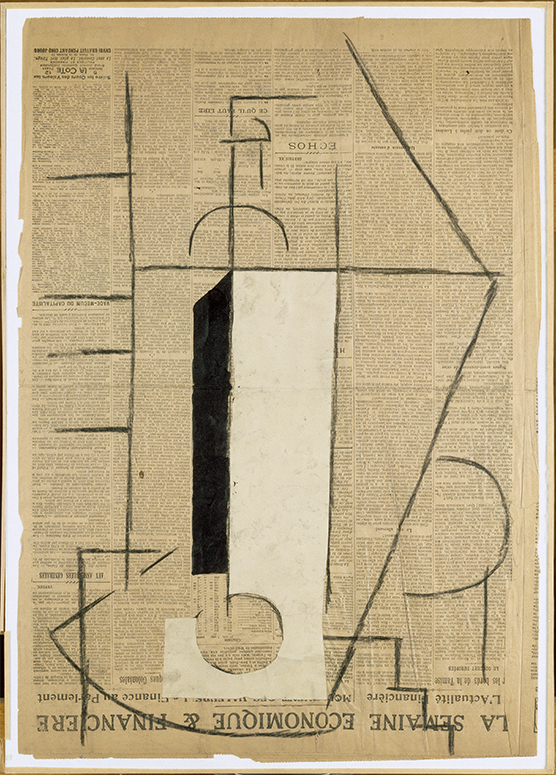The Provocation of the Unintelligible
The unusual presentation of a newspaper posted and seen on a wall rather than read from above, and placed upside-down in addition, leads viewers to lose their bearings. Presented in its new context (and barring unusual contortions), the newspaper becomes, quite literally, illegible. In addition, in the cultural context of 1912, when a work of art was necessarily a representation, this newspaper's illegibility was reinforced by the absence of any immediately identifiable figure (An object? A portrait? A landscape?). The illegibility of the background and the lack of definition of the figure together construct the isotopy of unintelligibility. This isotopy prevails in the piece; it is hence the measure of the ensemble of all possible readings. Several readings are undoubtedly possible, but not all. Any acceptable interpretations cannot overlook the question of a non-immediate meaning.
Semiotics considers that unintelligibility is nothing but a surface configuration arising from a particular semio-narrative structure at a deeper level. Therefore, unintelligibility is the conversion of the following structure:
- At the level of the discourse: The viewer does not understand the meaning of the collage. The author does.
- At the semio-narrative level: The "viewer" Subject is disjoined from the Object (the meaning of the work). He/She is opposed to the "author" Anti-Subject, conjoined to the Object. The Subject is modalized by /lack of knowledge/ while the Anti-Subject is modalized by /knowledge/.
However, if it so happens that two subjects do not have access to the same knowledge about an object, then this knowledge becomes an object of value in its own right, and therefore a narrative stake. The unintelligibility of this collage can therefore be described as a discourse built upon the dimension of knowledge (a cognitive dimension, that is). Is the meaning of this work a secret to be unveiled, jealously kept by the author? An imposture by this author, because, after all, it contains no figure? Or is it really a challenge to find meaning where apparently there is none to be found?
Moreover, the unintelligibility is deliberately presented. Yet an utterance–in this case, a work of art–that constructs its own unintelligibility can be analyzed according to the cultural form of provocation. What we refer to as "provocation" in turn implies a narrative discourse, which here is placed in the passional dimension. At the level of semio-narrative structures, the "viewer" Subject must reveal the provocation (Object) made by the "author" Addresser.
At this point in the reflection, and even before having spoken of a particular bottle, two narrative discourses have already been constructed by the collage: the story of a viewer who must respond to a provocation and a search for meaning stimulated by a work of art.
The first discourse belongs to a passional dimension: provocation. The second unfolds in the cognitive dimension: interpreting the meaning of a collage. These two discourses follow a hierarchical order, as the state of the passional subject depends on his or her interpretation of the piece.
We will now consider the cognitive dimension. Does this collage, which is the only utterance, enable the viewer to interpret the work? And if so, how? In other words, does this collage, the only mode of access to meaning, organize its own reading?





 Summary
Summary